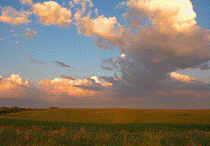
Proceedings of the North American Prairie Conferences
Date of this Version
2004
Document Type
Article
Abstract
Xeric, mixed-grass landscapes are changing rapidly as native grasslands are converted to cropland. We surveyed birds to compare their use of grassland and cropland habitats and to evaluate whether their abundances were related to grassland fragment size. Surveys were conducted in western South Dakota at 146 sites that were stratified by habitat type, landscape composition and fragment size. The abundances of 13 of 14 species were 1.2-140 times higher in grass- lands than in cropland. Greater prairie-chicken, sharp-tailed grouse, burrowing owl, Baird's sparrow, northern harrier, and short-eared owl never occurred in cropland. Abundances of grasshopper sparrow, western meadowlark and chestnut-collared longspur were higher in grassland than in any other habitat type. A positive relationship between grassland fragment size and grasshopper sparrow abundance indicates that it may not be enough to conserve small parcels of habitat even for the most common grassland species. The future of grassland bird populations will depend on grassland habitat conservation practices because most species are grass land specialists.


Comments
Published in Dave Egan & John A. Harrington, editors, Proceedings of the 19th North American Prairie Conference: The Conservation Legacy Lives On..., University of Wisconsin-Madison, August 8-12, 2004 (Proceedings of the North American Prairie Conference, 19), Madison, WI: University of Wisconsin-Madison, 2004.